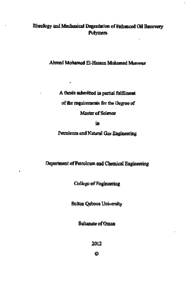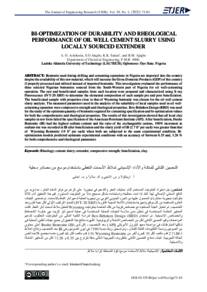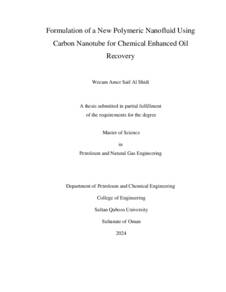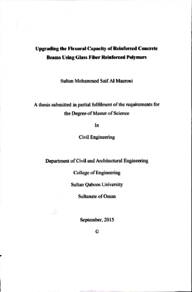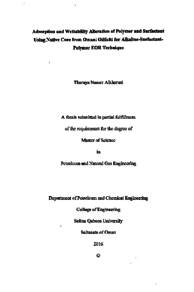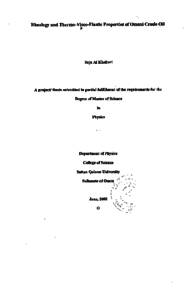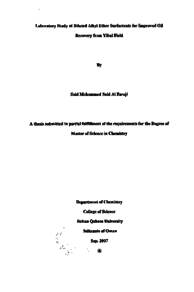Document
Rheology and mechanical degradation of enhanced oil recovery polymers
Publisher
Sultan Qaboos University
Gregorian
2012
Language
English
Subject
English abstract
A study of theological behavior and mechanical degradation of non-ionic and anionic polyacrylamides used in EOR/IOR applications has been carried out. Aqueous polymer solutions have been injected into stainless steel capillaries and core samples. Polymer degradation rate was evaluated from the flow induced viscosity loss of the polymer solution. Polymer degradation and mobility reduction were evaluated at different shear rates, salinities and concentrations.
The capillary study showed that increasing solvent salinity resulted in an increase in polymer degradation. From the evaluation of capillary entry point contribution to mobility reduction, three regions with different rheological behavior were observed; apparent thickening behavior until a critical shear rate, a plateau region, followed by a shear thinning behavior. Capillary length was found to impact more the degradation and mobility reduction of high salinity solutions. No impact of length was observed in low salinity solvents and distilled water. For the solutions tested, the non-ionic polymer showed relatively higher degradation.
Experiments on core samples revealed that polymer degradation in cores is low and no further degradation was observed above a critical shear rate. Degradation due to re-injection of polymer effluent into the core was found to be very small (3 - 5 %). Similar to capillaries, degradation increases with salinity. An apparent shear thinning behavior was observed at low shear rates until a critical shear rate above which shear thickening behavior took place.
This study showed that the two polymers are mechanically stable once flowing through the bulk of the formation. Also, the more flexible is the polymer in solution, the more degradable it is. Elongation flow at capillary entrance was found to be the main contributor to polymer degradation. This clearly indicates that degradation of the polymer in EOR/IOR applications could be mainly due to the presence of highly elongational flow through some surface and subsurface facilities (e.g. chocks) and at the sandface.
Member of
Resource URL
Arabic abstract
في هذا البحث تم دراسة سلوك تدفق بعض أنواع المواد الكيميائية التي تعرف بإسم البوليمر (PAM and HPAM) و التي تستخدم في تطبيقات تحسين إنتاجية النفط وذلك بضخها في أنابيب شعرية (Capillaries) وعينات صخرية (Core samples) ومن ثم دراسة تأثير تدفقها علي تماسكها و محافظتهاعلي خصائصها (اللزوجة و التدفق و تماسك الجزئيات).
أوضحت الدراسة إن زيادة درجة ملوحة السائل المستخدمة لتحضير محاليل البوليمر لها تأثير مباشر علي تأكل البوليمر. كذلك لوحظ وجود ثلاثة أشكال السلوك تدفق محلول البوليمر عند مدخل الأنابيب نتيجة لتنافس التدفق (Elongational flow) وهي: زيادة في الزوجة المحلول (Shear thickening) حتي معدل تدفق معين متبوعة بمنطقة ثبات ومن ثم نقصان في اللزوجة (Shear thinning) مع زيادة معدل التدفق.
ووجد أن طول الأنبوب الشعري كان له تأثير علي تدفق السائل و إضعاف تماسك البوليمر في المحاليل العالية الملوحة. وعلي العكس في حالة درجة الملوحة المنخفضة للمحلول لم يلاحظ أي تأثير لطول الأنبوب.
التجارب التي أجريت علي عينات الصخور أوضحت أن تأثير ضخ المحلول علي تأكل البوليمر كان قليلا ولم يلاحظ أي تأثير لمعدل تدفق المحلول بعد الوصول إلي معدل التدفق الحرج.
درجة تأكل البوليمر نتيجة لإعادة ضخه في العينات الصخرية كانت صغيرة (% 5-3) أماتأثير ملوحة المحلول علي سلوك التدفق وتأكل البوليمر فكان مشابها لماتم الحصول عليه في الأنابيب الشعرية
هذه الدراسة أوضحت أن نوعي البوليمر التي تم استخدامها لم يتأثرا ميكانيكا نتيجة لتدفق البوليمر في العينات الصخرية. بالإضافة إلى ذلك، البوليمر الأكثر مرونة كان هو الأكثر تأكلا. كم تم استنساخ أن تنافس تدفق البوليمر واستطالته عند مدخل الأنابيب و الممرات الضيقة أو المحدودة هو السبب الرئيسي في عملية تأكل البوليمر.
أوضحت الدراسة إن زيادة درجة ملوحة السائل المستخدمة لتحضير محاليل البوليمر لها تأثير مباشر علي تأكل البوليمر. كذلك لوحظ وجود ثلاثة أشكال السلوك تدفق محلول البوليمر عند مدخل الأنابيب نتيجة لتنافس التدفق (Elongational flow) وهي: زيادة في الزوجة المحلول (Shear thickening) حتي معدل تدفق معين متبوعة بمنطقة ثبات ومن ثم نقصان في اللزوجة (Shear thinning) مع زيادة معدل التدفق.
ووجد أن طول الأنبوب الشعري كان له تأثير علي تدفق السائل و إضعاف تماسك البوليمر في المحاليل العالية الملوحة. وعلي العكس في حالة درجة الملوحة المنخفضة للمحلول لم يلاحظ أي تأثير لطول الأنبوب.
التجارب التي أجريت علي عينات الصخور أوضحت أن تأثير ضخ المحلول علي تأكل البوليمر كان قليلا ولم يلاحظ أي تأثير لمعدل تدفق المحلول بعد الوصول إلي معدل التدفق الحرج.
درجة تأكل البوليمر نتيجة لإعادة ضخه في العينات الصخرية كانت صغيرة (% 5-3) أماتأثير ملوحة المحلول علي سلوك التدفق وتأكل البوليمر فكان مشابها لماتم الحصول عليه في الأنابيب الشعرية
هذه الدراسة أوضحت أن نوعي البوليمر التي تم استخدامها لم يتأثرا ميكانيكا نتيجة لتدفق البوليمر في العينات الصخرية. بالإضافة إلى ذلك، البوليمر الأكثر مرونة كان هو الأكثر تأكلا. كم تم استنساخ أن تنافس تدفق البوليمر واستطالته عند مدخل الأنابيب و الممرات الضيقة أو المحدودة هو السبب الرئيسي في عملية تأكل البوليمر.
Category
Theses and Dissertations

